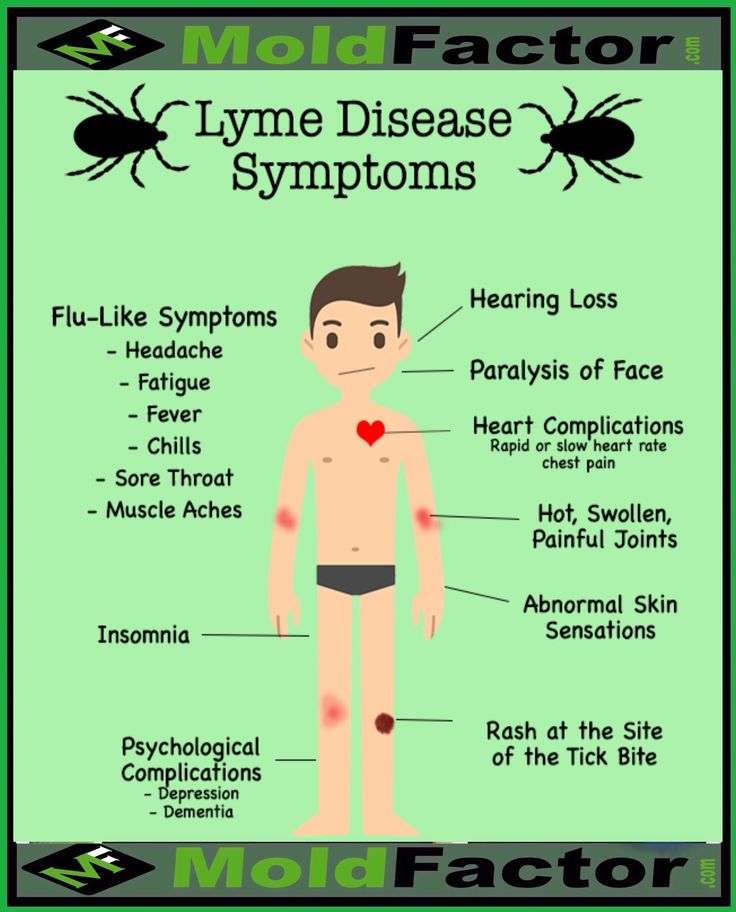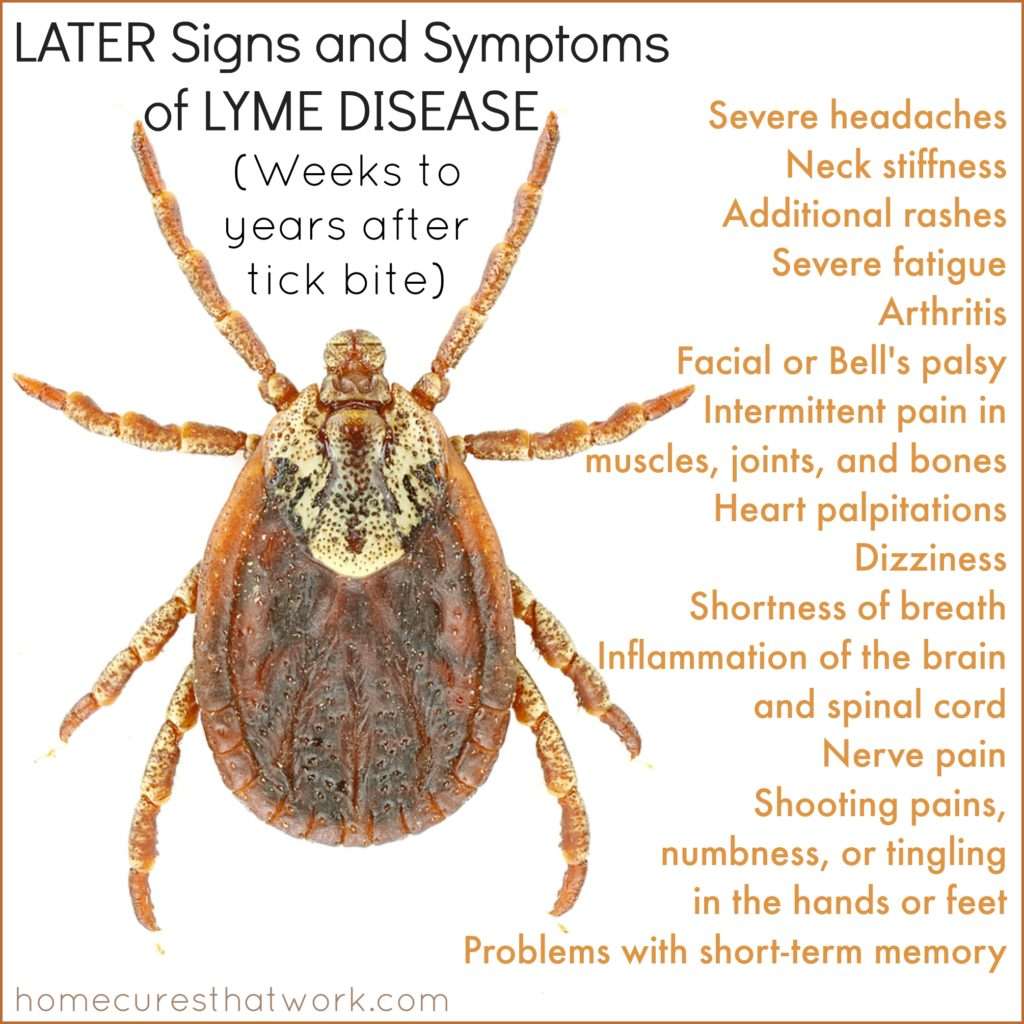What Are The Symptoms Of Lyme Disease
A bulls-eye rash, also called erythema migrans, is one of the telltale signs of Lyme disease. It usually appears at the site of a tick bite between 3 and 30 days after being bitten by an infected tick.
The rash may be warm but is not usually painful. Many people with early Lyme disease recall the appearance of a large bulls-eye rash. If the rash is not treated, it may spread to other parts of your body.
Rashes associated with Lyme disease may resemble other skin conditions.
Symptoms Of Late Stage Lyme Disease
The CDC reports that late stage Lyme disease may appear days to months after the initial tick bite and may include but are not limited to:
- Severe headaches and neck stiffness
- Additional EM rashes in new places on the body
- Facial palsy, also known as Bells palsy paralysis of one side of the face
- Arthritis or joint pain and swelling, especially of large joints
- Intermittent tendon, muscle, joint, nerve, or bone pain
- Heart palpitations or arrhythmia
- Dizziness or shortness of breath
- Inflammation of the brain or spinal cord
- Shooting pains, numbness, or tingling in the hands or feet
As mentioned above, late stage Lyme may also be characterized by the recurrence of early stage symptoms, such as fatigue.
Symptoms Check Out? Get Tested. Get Answers.
Can Lyme Cause Permanent Damage
Without treatment, Lyme can cause permanent damage. But most people with late-stage Lyme disease can recover if they get treatment with antibiotics. The longer you wait before treating Lyme disease, the longer it can take for symptoms to go away.
A small subset of people may have symptoms that persist after treatment. Some long-term complications people experience include:
-
Synovitis: This is inflammation of the linings of the joints. Up to 10% of people with late-stage Lyme have visible joint inflammation, even after antibiotic treatment. Immunosuppressive medications or surgery can sometimes help to reduce pain.
-
Post-treatment Lyme disease: This is also called chronic Lyme disease or post-lyme syndrome. It happens in around 10% to 20% of people who have had Lyme disease. Its similar to fibromyalgia and chronic fatigue syndrome. Symptoms include fatigue, widespread musculoskeletal pain, and problems with thinking and concentration.
-
Encephalitis, encephalomyelitis, or encephalopathy: These types of brain and spinal cord inflammation can cause long-standing problems with movement and thinking. These symptoms rarely persist after treatment.
-
Neuritis or neuropathy: This is inflammation of nerves outside of the brain, throughout the body. It can cause long-lasting problems with feeling and muscle strength even after treatment. These symptoms rarely persist after treatment.
Also Check: East Lyme Rent A Space
Does Heat Make Lyme Disease Worse
Some patients’ bodies have trouble regulating blood pressure and heart rate, and extreme temperatures can send those processes into distress. Common Lyme symptoms of dizziness, fatigue, and joint acheshard enough to deal with on a moderate dayare intensified in the heat of summer or the bitterness of winter.
Where Are Ticks Found

Ticks are found throughout the UK and in other parts of Europe and North America. There are a high number of ticks in the Scottish Highlands.
They can be found in any areas with deep or overgrown plants where they have access to animals to feed on.
They’re common in woodland and moorland areas, but can also be found in gardens or parks.
Read Also: Testing Deer Ticks For Lyme Disease
Early Detection Is Key
Lyme disease is easiest to treat at the early or acute stage, within the first 30 days of exposure. This is why its so important to take precautions to prevent tick bites, both during and outside of tick season. Protect yourself when near potential tick habitats, always perform tick checks after outdoor activity , and dont delay seeking medical attention if you notice any symptoms that might be related to tick-borne illness. Its important to get tested as soon as possible for the best chances of recovery.
How Is Lyme Disease Treated
Nearly all people with Lyme disease can be effectively treated with antibiotics, usually doxycycline or amoxicillin. The duration of treatment depends on the stage of infection. In general, the sooner such therapy is initiated following infection, the quicker and more complete the recovery.
Pregnant women should be treated for Lyme disease as well. There is, however, no evidence that a fetus can be infected from its mother. Additionally, NO strong evidence exists to suggest miscarriages are more likely after Lyme.
Don’t Miss: Mms Protocol For Lyme Disease
How To Remove A Tick
A tick must remain attached to the skin for at least 36 hours to spread Lyme disease. The best way of preventing Lyme disease is to remove a tick as soon as possible.
The blacklegged tick that spreads disease-causing bacteria resembles a tiny spider. Young ticks are around the size of a poppy seed, while adult ticks are around the size of a sesame seed. Ticks of all ages are reddish-brown.
Below are some steps for tick removal.
- Step 1: Use fine-tipped tweezers to gently grasp the tick near its head or mouth. Avoid squeezing the tick.
- Step 2: Using the tweezers, pull the tick carefully and steadily away from the skin. Avoid yanking or twisting the tick, as this could cause its mouthparts to remain in the skin.
- Step 3: After removing the tick, dispose of it by putting it in some alcohol or flushing it down the toilet.
- Step 4: Apply antiseptic to the tick bite.
You May Like: Dog Has Lyme Disease Now What
Enhancing Healthcare Team Outcomes
The key to Lyme disease is prevention and this requires an interprofessional team approach. All healthcare workers including the nurse practitioner, pharmacist, and primary care provider should provide patient education on measures to prevent tick bites while hiking or working outdoors. In areas where ticks are common, cleaning up of the environment by removing the underbrush and spraying an insecticide may reduce the tick burden in the area. The outdoors person should be told to wear appropriate garments and be familiar with the skin features of the tick bite. The nurse should educate the patient on how to remove the tick from the skin and when to seek medical assistance. The pharmacist should educate the patient on medication compliance for those who have been confirmed to have acquired Lyme disease.
Nurses should educate parents how to inspect their children for ticks at the end of an outdoor event, in an endemic area. While there are many repellants on the market, it is best to avoid them as the risk of harm is greater than any benefit. If one is going to use a repellant, DEET is the one product that is safe, however, it is not 100% effective. finally, the pharmacist should educate the patient about the harms of taking prophylactic doxycycline a better strategy is to remove the tick as soon as it is visualized.
Outcomes
You May Like: Late Stage Lyme Disease Symptoms
What Are The Symptoms Of Lyme Disease In Dogs
Lyme disease is often more challenging to identify in dogs than in humans, primarily due to the lack of a rash. While humans typically develop a characteristic “bullseye” rash around the location of the tick bite causing the infection, dogs don’t develop this rash. Instead, behavioral cues are used to identify canine Lyme disease.
Those symptoms include:
- Loss of appetite and/or weight loss
- Lameness in one or more parts of the body
- Stiffness or pain in one or more parts of the body
- Overall loss of energy
While tick bites are the cause of Lyme disease, the development of symptoms takes place much later than the initial bite. Your dog may not show symptoms of Lyme disease until two to five months after being infected. The signs of Lyme disease in dogs can also bear similarities to the symptoms of other health conditions. For this reason, it’s crucial that dog owners seek out a veterinary diagnosis if they suspect their pet has canine Lyme disease.
The Numbers On Chronic Lyme
Because Lyme disease is commonly missed or misdiagnosed, statistics vary on how many Lyme patients go on to experience chronic symptoms. The following research nonetheless paints a basic picture of the problem.
- An estimated 5-20% of patients may have chronic symptoms after getting Lyme disease, according to the Columbia University Irving Medical Center.
- The treatment failure rate for chronic Lyme disease patients was estimated at 26-50% in 2004, compared to 16-39% for early Lyme patients, according to Lymedisease.org.
- Up to 15-40% of late-stage Lyme patients develop neurological disorders, which are responsible for many common symptoms of chronic Lyme disease.
Experts dont know for sure why some people experience persistent symptoms, even with treatment. However, some believe the Lyme infection may trigger an auto-immune response that manifests in the chronic symptoms detailed below.
Read Also: How To Check If You Have Lyme Disease
Can Lyme Disease Be Prevented
People aren’t able to become immune to Lyme disease. So even if you’ve had Lyme disease, you can get it again. No vaccine is available currently to prevent the disease.
The FDA approved a Lyme vaccine called LYMErix in 1998. The vaccine was not 100% effective, however. The FDA still recommended preventing the disease in other ways. In 2002, the company that made LYMErix said it would no longer offer the vaccine.
To help prevent Lyme disease, follow these guidelines.
When Can I Get Lyme Disease

Lyme disease can occur during any time of the year. The bacteria that cause Lyme disease are spread by infected black-legged ticks. Young ticks are most active during the warm weather months between May and July. Adult ticks are most active during the fall and spring but may also be out searching for a host any time that winter temperatures are above freezing.
Read Also: Treatment For Lyme Disease Years Later
Early Disseminated Lyme Disease
Disseminated Lyme disease symptoms arise as the bacterial infection works its way to other bodily systems, organs, and structures. Typically a month or more after exposure, symptoms have changed and may include:
- Neck stiffness and headache
- Rashes on parts of the body other than the original
- Pain and severe swelling in the joints
- Facial palsy, a drooping and/or paralysis of parts of the face
- Inflammation and swelling of the brain and spine
- Heart arrhythmia, palpitations, or inflammation
- Pain, tingling, and numbness in hands and feet
- Periods of dizziness and shortness of breath
- Vision problems , in rare cases
Early Localized Lyme Disease
Early localized disease, the initial manifestation, begins between three and 30 days after a bite. It is characterized by:
- Bullseye rash and swelling,the most notorious symptom, occurs in 70% to 80% of cases. Clinically referred to as erythema migrans, its appearance variesit can be a different color or shapeespecially in people of color. It arises about a week after exposure to the bacteria.
- Other symptoms of the first stage include fever, fatigue, headache, and joint pain. Very often, those with the conditionespecially if there is no rashfeel as if theyre experiencing the flu.
Recommended Reading: Do All Ticks Carry Lyme Disease
What Happens If Lyme Disease Goes Untreated For Years
What Happens If Lyme disease goes untreated for years? Lyme disease that goes untreated for many months or years may be harder to treat with antibiotics. Untreated cases can progress to serious, even fatal health conditions, from arthritis and nerve pain to cardiac arrhythmia or Lyme neuroborreliosis .
How long does it take for Lyme disease to show up in blood test? The CDC cautions that because the test is not likely to be positive until 4 to 6 weeks after infection, doctors who suspect Lyme based on symptoms should prescribe antibiotics even if the test is negative. In practice, however, this doesnt always happen.
What is the most accurate test for Lyme disease? A blood test does not only detect Lyme disease it is the most accurate and preferred test for diagnosing the disease. If a patient with Lyme disease shows signs that the central nervous system has been affected by the disease, western blot testing on the cerebrospinal fluid can be performed.
How long does Lyme disease take to show up? From three to 30 days after an infected tick bite, an expanding red area might appear that sometimes clears in the center, forming a bulls-eye pattern. The rash expands slowly over days and can spread to 12 inches across.
Chronic Lyme Dos And Don’ts
Chronic Lyme disease is an ongoing Borrelia burgdorferi infection that can involve any body system or tissue. The infection produces a wide range of symptoms and signs, which can be debilitating for some patients. Common symptoms include severe fatigue, migratory musculoskeletal pain, headaches, and impaired memory. Unfortunately, chronic Lyme disease is complex and often misunderstood, which means that many patients will struggle to obtain the care they need to regain their health. Every patient concerned about Lyme disease and tick-borne illness should know the following.
You May Like: When Do Lyme Disease Symptoms Appear
What Are The Signs And Symptoms Of Lyme Disease By Stages
There are three stages of Lyme disease, which are outlined below.
Stage 1 Early Localized Disease
- Occurs one to 30 days after a tick bite
- characteristic skin rash of Lyme disease
- migrating red rash with bullseye appearance occurring at or near the site of the tick bite
- asymptomatic or itches orburns
- develops around seven days after the tick bite
- rash expands over a matter of days
- an untreated rash may persist for two to three weeks
Stage 3 Late Disease
Stage 3 Lyme disease occurs months to years after the initial infection or a period of latency. Most patients presenting with the late disease do not have erythema migrans because the rash urges the patient to seek treatment earlier.
Symptoms of Stage 3 Lyme Disease may include the following:
- Skin manifestation:
- Acrodermatitis chronica atrophicans: found almost exclusively in patients of European descent. It commonly affects older women with bluish-red discoloration on the back of the hands, feet, knees, and elbows.
You May Like: Lyme Disease And Lower Back Pain
Complications Of Untreated Lyme Disease
If unchecked, the Lyme disease infection can spread to other bodily systems, causing significant damage. Untreated, complications of this condition can be very severe:
- Arthritis:Prolonged infection with Lyme disease leads to chronic joint inflammation and swelling, usually in the knees . These symptoms tend to arise within two years of infection, with periods of flare-ups and remissions. This arthritis is relatively difficult to manage, though antibiotics and steroids may be attempted.
- Lyme carditis:If the bacteria reach the heart tissues, they can cause inflammation and lead to heart block. The electrical signals being sent between the upper and lower chambers of the heart are interrupted, impairing the coordination of the heartbeat. Though disruptive, this is rarely fatal.
- Lyme neuroborreliosis:Inflammation of multiple nerves, including those in the spine and brain, is the chief characteristic of this condition. This can also affect the meningesthe layer of tissue surrounding the brain and spineleading to meningitis, among other conditions. Antibiotic therapy, if applied promptly, tends to be effective as a treatment.
Even in cases where Lyme disease has progressed, antibiotic regimensespecially drugs like doxycyclineare generally successful in resolving problems.
Recommended Reading: Does Lyme Disease Cause Kidney Failure
What Is The Prognosis Of Lyme Disease
Prognosis is excellent and most patients recover completely, especially if treated early with appropriate antibiotics. Sometimes a recurrent infection can occur with certain strains, but Lyme disease can be managed well with medication. Co-infection by other organisms transmitted by the same tick bite can occur.
Also Check: Prophylactic Antibiotics For Lyme Disease
When To See A Healthcare Provider

Since Lyme disease can take different forms, and since its often confused with other conditions, its important to be proactive if you suspect the condition. What signs prompt medical help? Call the healthcare provider if:
- You have a bullseye rashor any kind of rashfollowing a tick bite.
- You experience flu-like symptoms after a tick bite.
- You experience symptoms of more advanced Lyme disease: arthritis, heart palpitations, facial paralysis, dizziness, and others.
Also Check: Where To Go For Lyme Disease Testing
What Can I Expect Long Term If My Child Has Lyme Disease
If Lyme disease is caught and treated early, most children will make a full recovery. Some children with Lyme disease go on to experience what’s called a post-infectious syndrome with symptoms that may include feeling fatigue, joint aches and pains, headaches, difficulty sleeping, and problems concentrating. Since the infection itself is gone by this time, doctors generally don’t prescribe antibiotics. Each child is different, but it’s not uncommon for symptoms of post-infectious syndrome to linger for months, or even years, and they can be made worse by stress or other illness. But most children do make a full recovery.
Blacklegged, or deer, ticks are very small, so it helps to know what to look for when doing a tick check. Adults are about the size of sesame seeds and in the nymph or larva stage, they can be as tiny as a poppy seeds.
How Is Lyme Disease Spread
Lyme disease is spread by the bite of an infected black-legged tick. The tick usually must be attached to a person for at least 24 hours before it can spread the germ. Black-legged ticks in Massachusetts can also carry the germs that cause babesiosis and human granulocytic anaplasmosis). These ticks are capable of spreading more than one type of germ in a single bite.
Also Check: Amoxicillin Vs Doxycycline For Lyme